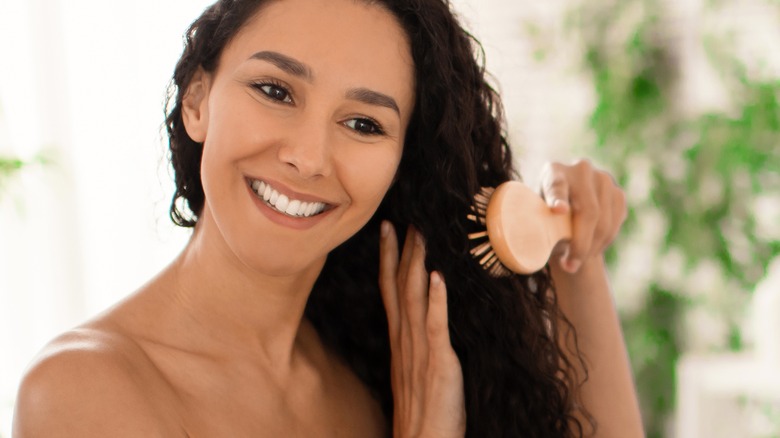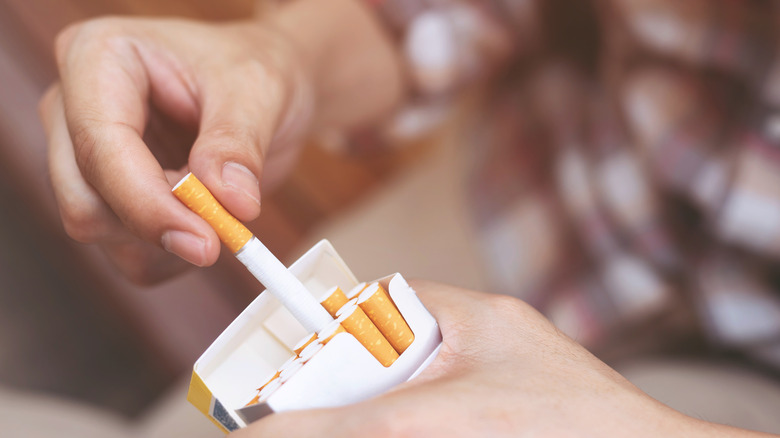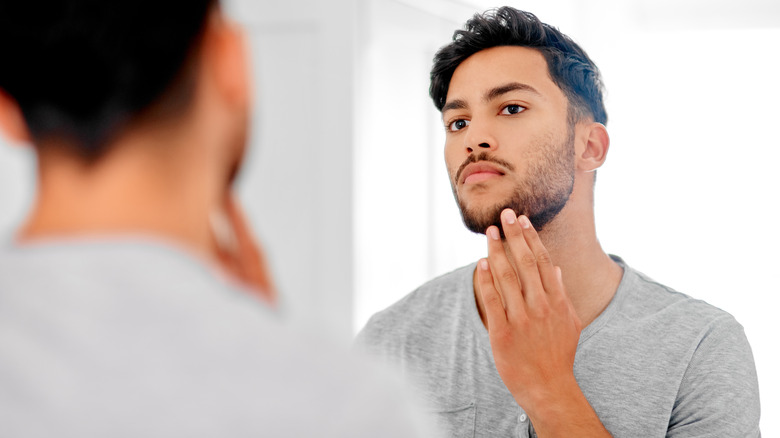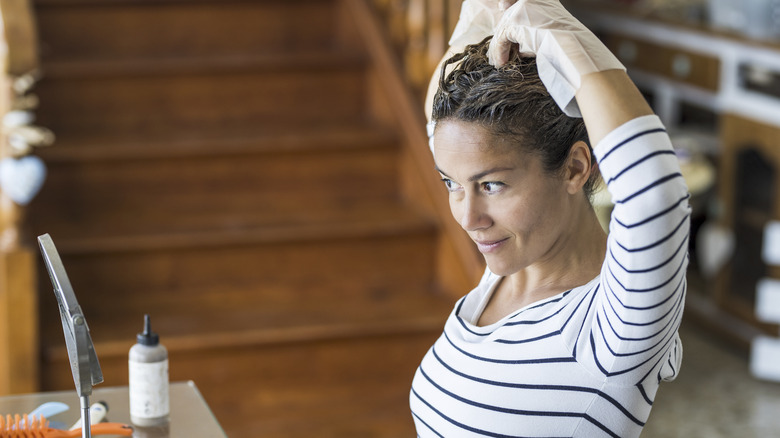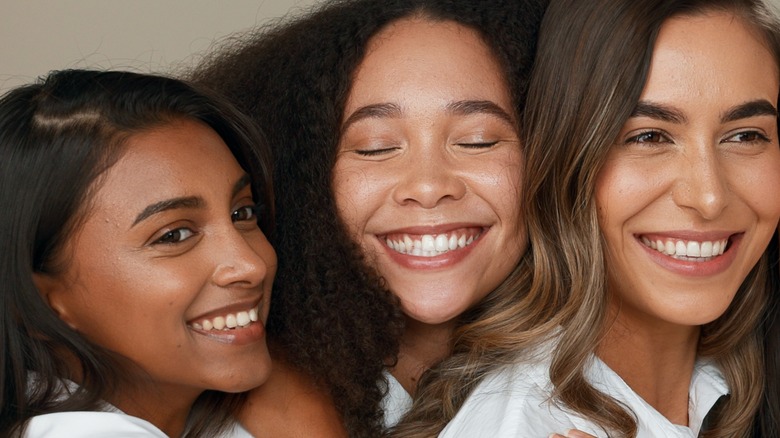The Unfortunate Health Drawbacks Of Being Brunette
What do stars like Zendaya, Eva Mendes, and Anne Hathaway have in common? Aside from lighting up the silver screen with powerhouse performances, they're all natural brunettes. With nearly 20% of the population possessing brown hair, the actresses are in good company, reports World Atlas. However, simply describing someone's hair as "brown" fails to encapsulate all the rich variety that exists in being brunette. According to Cutters His & Hers Hairdressing, some of the most common shades of brown hair you'll find around the world range from maple brown to walnut brown, light brown, and dark brown. As you can see, there's no such thing as one-shade-fits-all when it comes to being a brunette.
The melanin in your hair is what influences its natural color. Those with dark hair possess a specific type of melanin known as eumelanin. The greater the amount of eumelanin in your hair, the more likely you are to have black hair. Conversely, people with blonde hair have minimal amounts of eumelanin. This leaves brunettes falling somewhere in the middle, which is what gives them either their lighter or darker shade of brown hair. Whether your hair is black, blonde, red, brown, or anywhere in between, there are pros and cons to each and every hue, including those related to your health. Here are a few potential cons you might be surprised to learn are associated with being brunette.
You may be more prone to moles
It has long been thought that people whose skin or hair contains less melanin are more likely to be affected by the sun's UV rays. But that doesn't mean only blondes or people with red hair may leave the beach with a nasty sunburn. In addition to freckles and age spots, moles can also develop as a result of sun exposure.
Researchers from a 2010 study published in the Journal of the American Academy of Dermatology set out to see if hair color factored into sun sensitivity and the development of moles in young kids. The study team examined more than 650 non-Hispanic white children in Colorado and found that 9-year-old kids with dark hair who experienced sunburn followed by a mild tan developed more moles than kids with light hair with the same degree of sun sensitivity. While they are the product of skin cell overgrowth, moles are most often not a sign of cancer, reports MedlinePlus. However, the researchers determined that people with dark hair may potentially be at greater risk for melanoma than previously thought.
You may be more likely to develop a nicotine addiction
Smoking comes with no shortage of potential health risks, from lung disease to cancer, diabetes, chronic obstructive pulmonary disease (COPD), stroke, and more. People who smoke may also develop an addiction to nicotine. According to the National Institute on Drug Abuse, the stimulant drug gives your brain a hit of dopamine in as little as 10 seconds after puffing on a cigarette, which can leave you coming back for more. Some people may be more prone to developing a nicotine addiction, and unfortunately, this includes brunettes.
In a 2006 scientific review published in Nicotine & Tobacco Research, researchers explain how melanin, metabolism, and nicotine uptake all play into one another. Nicotine buildup occurs in the tissues of the body that harbor melanin, but it's melanin that also slows the body's ability to metabolize nicotine. This means that nicotine spends more time hanging out in your body. This was evidenced in an early 1999 animal study in which pigmented mouse hairs were found to contain greater concentrations of three different drugs, including nicotine, in comparison to non-pigmented mouse hairs. The more time nicotine spends in your body, the greater the likelihood of addiction.
If you or anyone you know needs help with addiction issues, help is available. Visit the Substance Abuse and Mental Health Services Administration website or contact SAMHSA's National Helpline at 1-800-662-HELP (4357).
You may start going gray a little earlier than your blonde friends
It's inevitable: we all start to notice those wiry gray hairs sprouting up from our scalps eventually. Going gray is a beautiful and natural part of aging, and some people hardly consider it a drawback. However, others may prefer to preserve the color in their hair for as long as possible. For those with blonde hair, this preservation may extend until roughly the age of 35, according to survey research conducted by haircare expert Charles Worthington of Charles Worthington Instant Root Concealer (via Daily Mail). For brunettes, however, British female participants reported their first silver hair making its debut at the average age of 32 — three years earlier than blonde participants. Women with brown hair may have lucked out over those with red hair, however, who reported going gray starting at around age 30.
While survey data certainly has its place in the world of research, such results should be taken with a grain of salt, as the outcomes are largely anecdotal. Rather, a number of different factors can influence at what age you begin to go gray, including race (via The Journal of Clinical and Aesthetic Dermatology), gender (via The New York Times), vitamin deficiencies, or the presence of certain health conditions, explains Harvard Health Publishing. While the research isn't definitive, stress may also factor into graying. More often than not, though, the rate at which you gray is dictated by your genetics.
If you've ever dyed your hair brown, you may be at risk for certain cancers
Although research has produced conflicting results, those who are brunette by choice may be susceptible to certain cancers. The American Cancer Society reports that some studies indicate the use of hair dye, particularly dark colors, may increase one's risk for some non-Hodgkin lymphomas. Non-Hodgkin lymphoma targets the body's lymph nodes, which, depending on what stage the disease is in, may include those located in the upper and/or lower body (via Moffitt Cancer Center). This same link has also been seen in association with the use of hair dye prior to 1980. Experts state this is likely due to the use of cancer-related chemical ingredients in dye products that have since been removed over time.
Similarly, a 2020 study published in the British Medical Journal (BMJ) alternatively found that naturally dark-haired women who had used permanent hair dye, even just once in their life, appeared to be at greater risk for Hodgkin lymphoma than women who had never used permanent hair dye. No such connection was found among participants with naturally light hair. Unlike non-Hodgkin lymphoma, Hodgkin lymphoma tends to initially develop in the upper body. To learn more, here are some additional differences between Hodgkin lymphoma and non-Hodgkin lymphoma.
Are there any perks to being brunette?
If you've read this far, and are now feeling a little dismayed about being a brunette, know that your gorgeous brown mane brings with it many health benefits, too. For one, melanin-rich hair may be better protected against the elements, helping to preserve its vitality. "Indeed, melanin plays a protective role: Larger quantities of eumelanin protect hair against high levels of exposure to the sun and its unwanted consequences such as drying out and brittleness," certified hair stylist Nikki Goddard told Healthline. Not only that, but Self reports that people with blonde hair actually shed the most in comparison to those with alternate hair colors — although brunettes can't deny that their shedding may be harder to hide.
Additionally, being brunette may lower your risk for Parkinson's disease (PD). Impacting the body's nervous system, Mayo Clinic experts explain that people with Parkinson's disease may experience tremor, muscle rigidity, slowed movements, balance difficulty, and more. Researchers from a 2010 study published in the scientific journal Annals of Neurology found that people with dark hair had the least amount of risk for Parkinson's disease compared to people with lighter hair. Out of four groups, people with black hair were the least susceptible, followed by individuals with brown hair. Individuals with blonde hair were found to be the second-most prone group to PD, with red-haired people at greatest risk.

